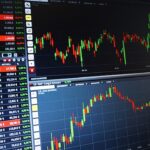This article provides an overview of range trading strategies, including how to identify a range, set entry and exit points, and manage risk.
Identifying a Range
In the world of financial markets, a range refers to the horizontal price movement of an asset within a specific period. Range trading involves identifying these price boundaries and taking advantage of the repeated reversal patterns that occur within them. Traders typically look for areas where price consistently bounces between a support level (lower boundary) and a resistance level (upper boundary).
Setting Entry and Exit Points
Once a range has been identified, traders can set entry points near the support level and exit points near the resistance level, taking advantage of the price fluctuations within the boundaries. Entry points are often determined using technical indicators such as moving averages or oscillators for confirmation.
When setting exit points, traders aim to capture profits before the price reaches the opposite boundary of the range or when signs of a trend reversal appear. Setting a stop-loss order is crucial in range trading to limit potential losses if the price breaks out of the established range.
Managing Risk
Managing risk is a critical aspect of any trading strategy. In range trading, traders often use a risk-to-reward ratio to determine the potential profit compared to the potential loss. By setting a favorable risk-to-reward ratio, traders can ensure that even if they have some losing trades, their overall profitability remains positive.
Diversifying the range trading portfolio by including assets from different sectors or using multiple timeframes can also help manage risk. This strategy can reduce the impact of specific asset volatility or sudden market movements.
Table: Comparison of Range Trading Strategies
| Strategy | Definitive Features | Alternatives |
|---|---|---|
| Breakout | Wait for the price to break out of the range and trade in the direction of the breakout. | Fading the breakout – expecting the price to reverse after a false breakout. |
| Bollinger Bands | Use the upper and lower bands to identify overbought and oversold levels within a range. | Stochastic oscillator – another indicator that identifies potential overbought and oversold levels. |
| Moving Average Convergence Divergence (MACD) | Identify crossovers or divergences in the MACD histogram to signal potential trend reversals within a range. | Relative Strength Index (RSI) – measures the speed and change of price movements to identify potential reversals. |
FAQs
Q: Can range trading be applied to all types of financial markets?
A: Range trading strategies can be applied to various financial markets, including stocks, currencies, commodities, and indices.
Q: What are some common indicators used in range trading?
A: Some commonly used indicators in range trading include Bollinger Bands, Moving Average Convergence Divergence (MACD), stochastic oscillator, and Relative Strength Index (RSI).
Q: How can I determine the strength of a range?
A: The strength of a range can be determined by the number of times price bounces off the support and resistance levels and the duration of the range. Strong ranges often demonstrate multiple bounces and last for a longer duration.
Conclusion
Range trading strategies provide traders with opportunities in markets that exhibit consistent price movements within specific boundaries. By identifying ranges, setting entry and exit points, and managing risk through proper risk-to-reward ratios and portfolio diversification, traders can achieve profitability in range-bound markets.





